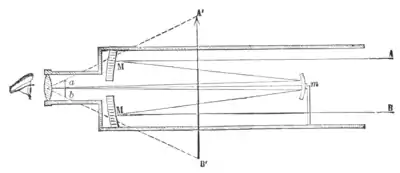160
THE WONDERS OF OPTICS
another and very important class of instruments, in which the object-glass is replaced by a reflecting mirror. The first reflecting telescope was invented by Dr. Gregory, an English philosopher, about 1650. It consisted of a brass tube, at the lower extremity of which was fixed a concave mirror made of metal, and provided with a hole in its centre for the insertion of the small tube containing the eye-glass. Towards the other end of the telescope was placed a second and smaller mirror, which reflected the image formed by the large mirror, through the eye-piece to the eye. The following figure will show the path of the rays in the Gregorian telescope.

Fig. 44.—Section of the Gregorian Telescope.
The rays A B, proceeding from the object at which the instrument is pointed, are first reflected from the surface of the principal mirror M M on to the small mirror m, whence they proceed to form a magnified image at a b, which is then again enlarged by the eye-piece appearing to the eye as if placed at A' B'. The focus in the Gregorian is altered, not by sliding the eye-piece backwards and forwards but by moving the mirror m, which is provided with a long screw, to which is attached a handle. At first sight a reflecting tele-